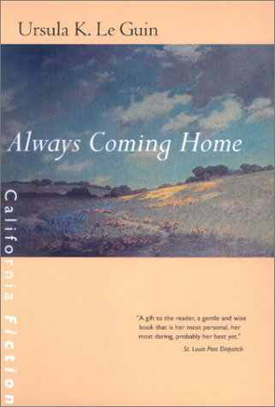 Some fifteen years ago, Le Guin created Always Coming Home, an ethnographic history of a people living in a future version of Northern California. Though it’s possible that this might be a far future version of our culture, Le Guin cares not a bleedin’ bit about where or when this takes place; the intent here is world building at its very finest. And world building that is very anthropological in nature. Always Coming Home has been reprinted sans the music and poetry of the Kesh cassette tape by the University of California Press as ‘a California novel’.
Some fifteen years ago, Le Guin created Always Coming Home, an ethnographic history of a people living in a future version of Northern California. Though it’s possible that this might be a far future version of our culture, Le Guin cares not a bleedin’ bit about where or when this takes place; the intent here is world building at its very finest. And world building that is very anthropological in nature. Always Coming Home has been reprinted sans the music and poetry of the Kesh cassette tape by the University of California Press as ‘a California novel’.
Le Guin was born on the 21st of October, 1929, in Berkeley, California, where she grew up. She’s the daughter of Alfred L. Kroeber, an anthropologist, and Theodora Covel Brown Kracaw Kroeber, another anthropologist. She attended Radcliffe College, which was then still all-female, and did her graduate work at Columbia University, where she studied Romance Literature of the Middle Ages and Renaissance, especially French. She met and married Charles A. Le Guin (pronounced Luh Gwinn) while they were both on Fulbright
scholarships in France. He became a professor of French History at Portland State College, Oregon, where they still live. They have three children: Elisabeth, Caroline, and Theodore; and at least two grandchildren. She has produced over eighty short stories, several collections of essays, ten books for children, several volumes of poetry, and at least sixteen novels.
So what do we have here? What we have is a marvelous collection of ‘an anthropology of the future’. Le Guin excavates tales, songs, beliefs, myths, traditions, cooking habits, tribal structures, and mores of the people who ‘will be might have been’ someday living in what is, as I previously noted, now Northern California. If you’ve read either The Dispossessed or The Earthsea Cycle by her, you know that she’s an obsessive creator of extremely detailed cultures. However, most of her work actually has a traditional narrative framework of characters involved in a story that has a beginning, a middle, and an end. Sorry, me dear readers, but that is not the case here. This is the antithesis of Tolkien’s Lord of the Rings. Tolkien’s world has virtually no ethnographic detail, while Le Guin’s has no history. Yes, no history — The Kesh, the tribe in Always Coming Home, exist outside of time itself, dwelling almost literally within what the First People of Australia called ‘the eternal present’.
The subject of Always Coming Home is the Kesh — a people who inhabit a valley in a far-future California. The Kesh are noticeably based on First People models — though Le Guin uses a matrilineal tribal structure, which is not known to have existed in any of the North American First Peoples. (First People and First Nation can be used interchangeably.) Le Guin lets the Kesh speak for themselves, allowing the reader to learn about them through a patchwork quilt of short stories, poems, and myths. These are framed around a novella which tells the story of a woman called Stonetelling who leaves the valley to live with her father’s people, the Condor. (Coyote also makes an appearance.) Like any academic work, the “back of the book” contains additional information about the Kesh in a traditional ethnographic form. Hell, there’s more supplementary material here that you’ll see in most Ph.D. dissertations!
Always Coming Home is worth reading in large part because it can be — and definitely should be — read in very small pieces. Go ahead — get a cuppa of heather-smoked tea, find a comfortable chair, and read ‘Four Romantic Tales’, which are popular folk tales of the Kesh, or ‘How to Die in the Valley’, which is a fascinating look at the burial customs of this culture. It took me months to read Always Coming Home because I read a wee bit at a time in the evenings, but that way it felt like I was watching a culture unfold before me eyes. This is brilliant storytelling, but it is not, despite the press release from the University of California, a novel.
But don’t bother getting the older version with the music and poetry of the Kesh as it adds nothing to the story. As theatre, it sucks; as music, it is boring at best. And no, I have no idea what the geomancer credited below had to do with this endeavour!
Other creative personnel were Todd Barton (music), Margaret Chodos-Irvine (Illustrator) and George Hersh (Geomancer).
(Harper & Row, 1985; University of California Press, 2001)
